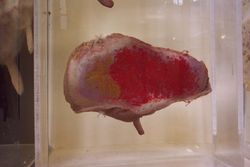Mammary Gland - Horse Anatomy
| This article is still under construction. |
Overview
The mamma (pleural = mammae) is the glandular structure associated with a papilla (teat) and may contains two ducts in the mare. The udder is a term designating all the mammae in the mare. The mammary glands of the mare are close together, forming a small udder in the inguinal region. There is an intermammary groove separating the left and right halves. Each half comprises a single mammary complex, which each has two mammary units. The lobes are the internal compartments of the mamma, separated by adipose tissue. The lobes are divided into lobules, consisting of connective tissue containing alveoli, which are clusters of milk secreting cells. The lactiferous ducts are large ducts conveying milk from the alveoli to the lactiferous sinus. The openings of the lactiferous ducts convey milk formed in the alveolus to the gland sinus.
The lactiferous sinus (milk sinus) is the milk storage cavity within the teat and glandular body. The gland sinus is part of the milk sinus within the glandular body and the teat sinus is part of the milk sinus within the teat.
The teat is the projecting part of the mammary gland containing part of the milk sinus. The papillary duct (teat canal) is the canal leading from the teat sinus to the teat opening and may be single or multiple. The ostium (teat opening) is the opening of the papillary duct and the exit point for milk or entrance point for bacteria. The sphincter consists of muscular fibres surrounding the teat opening that prevent milk flow except during suckling or milking. The teats are short in the mare. In late pregnancy, sebacious secretions, epithelial debris and colustrum escape and accumulate around the teat; giving it a waxy appearance. This 'waxing up' can be a sign of impending parturition.
Vasculature
Arteries
The main blood supply to the inguinal mammary glands is from the external pudendal artery. This arises indirectly from the external iliac artery via the deep femoral artery. The external pudendal artery passes through the inguinal canal.
Veins
The thoracic and cranial abdominal mammary glands drain via cranial superficial epigastric veins into the internal thoracic vein. Caudal abdominal and inguinal mammary glands drain via caudal superficial epigastric veins into the external pudendal vein.
Lymphatics
The more caudal mammary glands drain to the superficial inguinal lymph node and the more cranial mammary glands to the axillary or sternal lymph nodes.
Innervation
Somatic innervation is via the ventral rami of the spinal nerves. Mammary branches of the pudendal nerve supply the caudal aspect of the udder. There is sympathetic innervation to the blood vessels and teat sphincter smooth muscle. Mammary glands also have major influence from endocrine hormones.
Lactation
Mammary gland development is initiated prenatally in the female foetus and continues through puberty and pregnancy. Secretion of milk does not begin until shortly (hours) before parturition. Lactation provides the neonate with the opportunity to nurse and be nourished with minimal energy expenditure. It also provides immunoprotection for the neonate because initial mammary secretions (colostrum) contain antibodies that provide passive immunity. Lactation continues until the neonate is weaned. After weaning, the mammary glands undergo involution and return to a non-secretory state.
Key words
- Mammogenesis: the development of mammary tissue
- Lactogenesis: the onset of milk secretion
- Galactopoesis: the maintenance of lactation
- Milk ejection: the expulsion of milk from alveoli
- Involution: termination of milk secretion and mammary gland regression.
Involution
As the requirement for milk by the neonate decreases, suckling is less frequent. Consequently, there is a buildup of pressure in the mammary gland causing secretory cells to become increasingly less functional - pressure atrophy. Secretory cells then remain non-functional until a subsequent pregnancy, at which time prolactin, glucocorticoids and placental lactogen restimulate alveolar milk synthesis. During involution, immune cells such as lymphocytes and macrophages invade the mammary tissue. These produce immunoglobulins in the subsequent lactation. Involution is critical to allow the replacement of senescent secretory cells which are lost by apoptosis.
